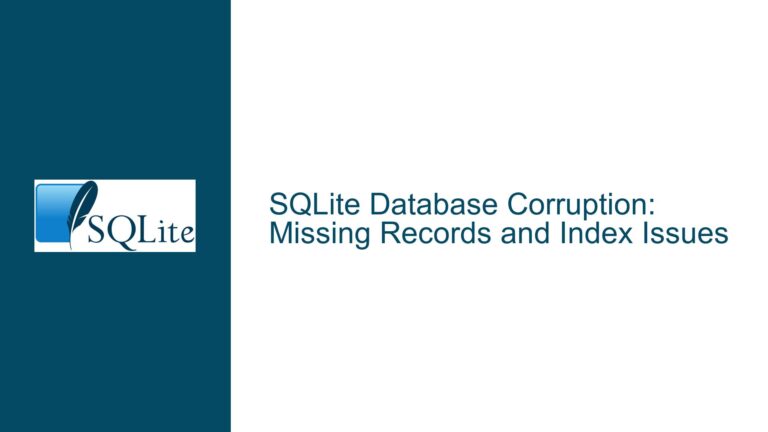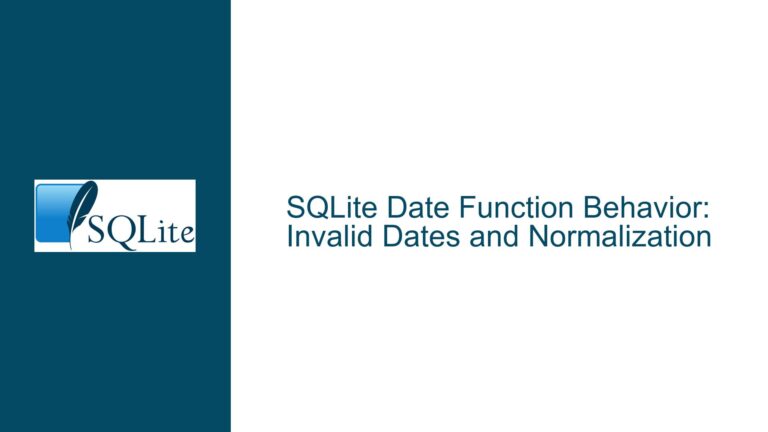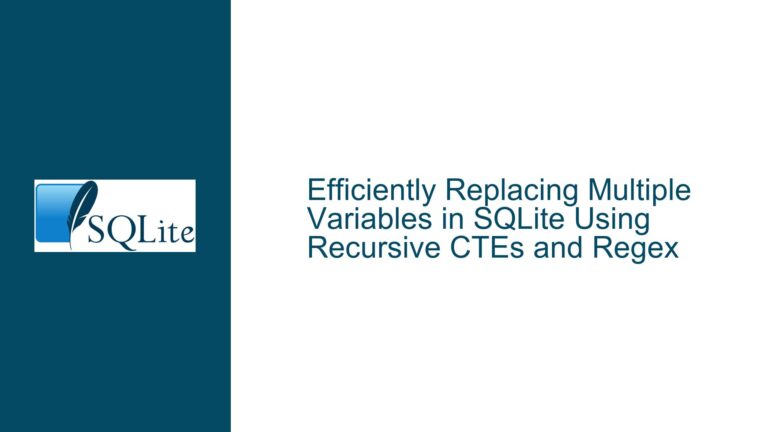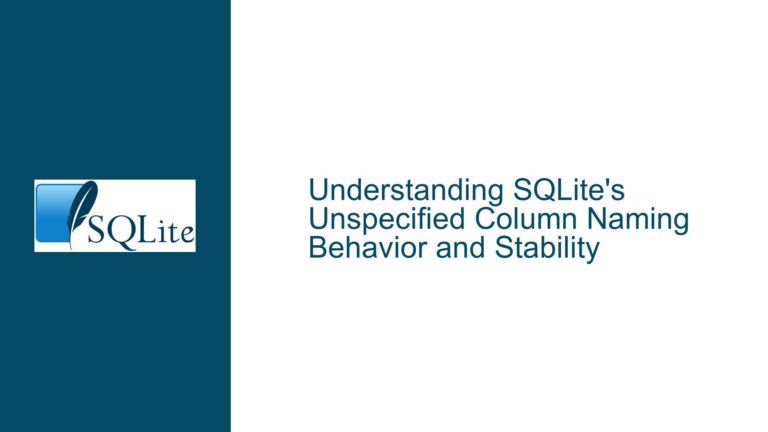SQLite RETURNING Clause Causes SQLITE_BUSY Error on Commit
Issue Overview: RETURNING Clause in Transactions Leads to SQLITE_BUSY Error
When using the RETURNING clause in SQLite within a transaction, particularly with INSERT statements, users may encounter an error code 5 (SQLITE_BUSY) when attempting to commit the transaction. The error message typically states: "cannot commit transaction – SQL statements in progress." This issue arises because the RETURNING clause introduces a result set that must be fully consumed before the transaction can be committed. If the result set is not fully consumed, SQLite considers the statement to still be in progress, thereby preventing the transaction from being committed.
The RETURNING clause, introduced in SQLite 3.35.0, allows users to retrieve the values of the inserted, updated, or deleted rows directly within the same SQL statement. While this feature is powerful and simplifies certain workflows, it introduces a new layer of complexity when used within transactions. Specifically, the result set generated by the RETURNING clause must be fully iterated over before the transaction can be successfully committed. Failure to do so results in the SQLITE_BUSY error, as SQLite interprets the un-consumed result set as an ongoing SQL operation.
This issue is particularly prevalent in environments where the SQLite C interface or higher-level language bindings (such as Python’s APSW) are used. The problem is exacerbated by the fact that many developers may not be aware of the need to fully consume the result set generated by the RETURNING clause, especially if they are accustomed to working with databases that handle such cases automatically.
Possible Causes: Unconsumed Result Sets and Transaction State Mismanagement
The root cause of the SQLITE_BUSY error when using the RETURNING clause in transactions lies in the interaction between the result set generated by the RETURNING clause and the transaction state management in SQLite. When an INSERT statement with a RETURNING clause is executed, SQLite generates a result set containing the values specified in the RETURNING clause. This result set must be fully consumed before the transaction can be committed. If the result set is not fully consumed, SQLite considers the statement to still be in progress, which prevents the transaction from being committed.
Several factors contribute to this issue:
Incomplete Iteration Over Result Sets: Developers may inadvertently fail to fully iterate over the result set generated by the
RETURNINGclause. This can happen if the code only retrieves a subset of the rows or if an error occurs during iteration, causing the process to terminate prematurely.Misunderstanding of Transaction Boundaries: Some developers may not fully understand the implications of using the
RETURNINGclause within transactions. They may assume that the transaction can be committed immediately after executing theINSERTstatement, without realizing that the result set must be fully consumed first.Language Binding-Specific Behavior: Different language bindings for SQLite (such as APSW in Python) may handle result sets and transactions differently. In some cases, the binding may not provide clear indications that the result set must be fully consumed before committing the transaction.
Resource Management Issues: In some cases, resource management issues (such as memory leaks or cursor mismanagement) can prevent the result set from being fully consumed, leading to the
SQLITE_BUSYerror.Concurrency and Locking: Although less common in this specific scenario, concurrency and locking issues can also contribute to the
SQLITE_BUSYerror. If another process or thread holds a lock on the database, it may prevent the transaction from being committed, even if the result set has been fully consumed.
Troubleshooting Steps, Solutions & Fixes: Ensuring Proper Result Set Consumption and Transaction Management
To resolve the SQLITE_BUSY error caused by the RETURNING clause in transactions, developers must ensure that the result set generated by the RETURNING clause is fully consumed before attempting to commit the transaction. Below are detailed steps and solutions to address this issue:
Fully Iterate Over the Result Set: The most straightforward solution is to ensure that the result set generated by the
RETURNINGclause is fully iterated over before committing the transaction. This can be done by explicitly fetching all rows from the result set until the iterator is exhausted. For example, in Python using APSW, this would involve callingnext(cursor)until aStopIterationexception is raised.Use Explicit Cursor Management: In environments where cursors are used to execute SQL statements, developers should ensure that the cursor is properly managed and that all rows are fetched before committing the transaction. This may involve using a loop to fetch rows until no more rows are available.
Check for Errors During Iteration: Developers should implement error handling to ensure that any errors during the iteration process do not prevent the result set from being fully consumed. This includes catching exceptions and ensuring that the iteration process continues even if an error occurs.
Understand Transaction Boundaries: Developers should have a clear understanding of transaction boundaries and the implications of using the
RETURNINGclause within transactions. This includes recognizing that the transaction cannot be committed until the result set is fully consumed.Use Language Bindings That Handle Result Sets Automatically: Some language bindings for SQLite may provide higher-level abstractions that handle result sets and transactions automatically. Developers should consider using such bindings if they are available and suitable for their use case.
Debugging and Logging: Developers should implement debugging and logging to track the state of the result set and transaction. This can help identify cases where the result set is not fully consumed and provide insights into the root cause of the issue.
Resource Management: Ensure that resources such as cursors and connections are properly managed and released. This includes closing cursors and connections when they are no longer needed to prevent resource leaks that could interfere with transaction management.
Concurrency and Locking Considerations: While not directly related to the
RETURNINGclause, developers should be aware of concurrency and locking issues that could contribute to theSQLITE_BUSYerror. This includes ensuring that no other processes or threads hold locks on the database that could prevent the transaction from being committed.Testing and Validation: Developers should thoroughly test their code to ensure that the result set is fully consumed and that the transaction can be committed without errors. This includes testing edge cases and scenarios where errors may occur during the iteration process.
Consult Documentation and Community Resources: Developers should consult the SQLite documentation and community resources to gain a deeper understanding of the
RETURNINGclause and its implications for transaction management. This can help prevent common pitfalls and ensure that best practices are followed.
By following these steps and solutions, developers can effectively troubleshoot and resolve the SQLITE_BUSY error caused by the RETURNING clause in transactions. Properly managing result sets and transaction boundaries is key to ensuring that SQLite operations are executed smoothly and without errors.






